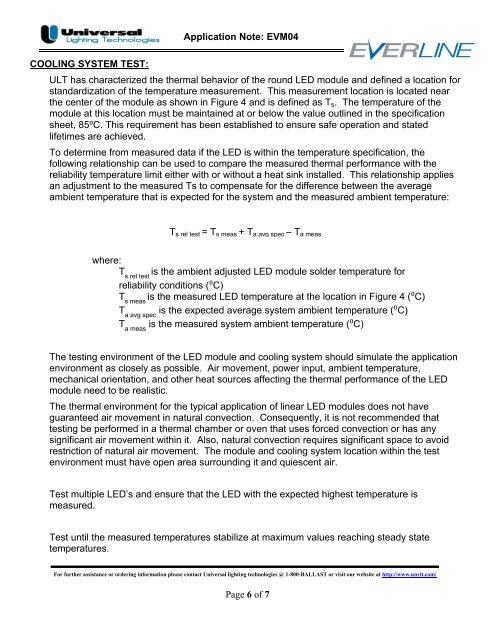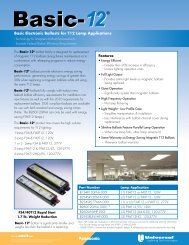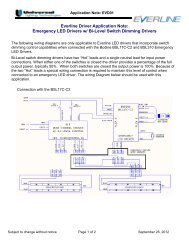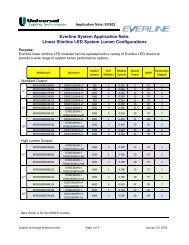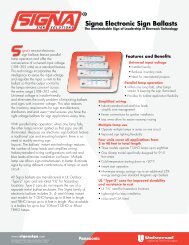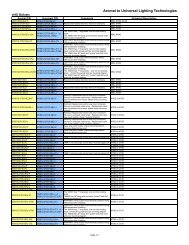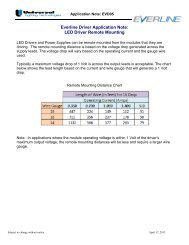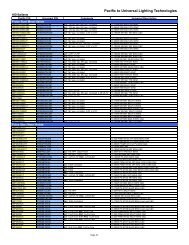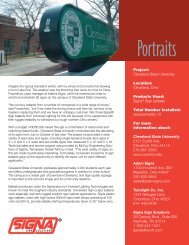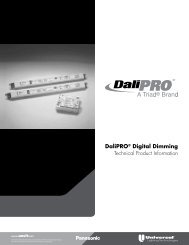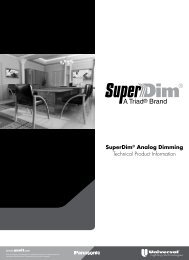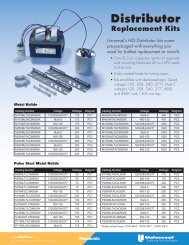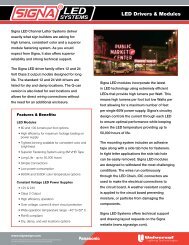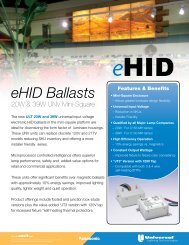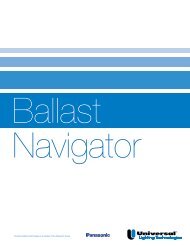Round LED Module Thermal Management - Universal Lighting ...
Round LED Module Thermal Management - Universal Lighting ...
Round LED Module Thermal Management - Universal Lighting ...
Create successful ePaper yourself
Turn your PDF publications into a flip-book with our unique Google optimized e-Paper software.
Application Note: EVM04<br />
COOLING SYSTEM TEST:<br />
ULT has characterized the thermal behavior of the round <strong>LED</strong> module and defined a location for<br />
standardization of the temperature measurement. This measurement location is located near<br />
the center of the module as shown in Figure 4 and is defined as T s . The temperature of the<br />
module at this location must be maintained at or below the value outlined in the specification<br />
sheet, 85⁰C. This requirement has been established to ensure safe operation and stated<br />
lifetimes are achieved.<br />
To determine from measured data if the <strong>LED</strong> is within the temperature specification, the<br />
following relationship can be used to compare the measured thermal performance with the<br />
reliability temperature limit either with or without a heat sink installed. This relationship applies<br />
an adjustment to the measured Ts to compensate for the difference between the average<br />
ambient temperature that is expected for the system and the measured ambient temperature:<br />
T s rel test = T s meas + T a avg spec – T a meas<br />
where:<br />
T s rel test<br />
is the ambient adjusted <strong>LED</strong> module solder temperature for<br />
reliability conditions (⁰C)<br />
T s meas<br />
is the measured <strong>LED</strong> temperature at the location in Figure 4 (⁰C)<br />
T a avg spec<br />
is the expected average system ambient temperature (⁰C)<br />
T a meas<br />
is the measured system ambient temperature (⁰C)<br />
The testing environment of the <strong>LED</strong> module and cooling system should simulate the application<br />
environment as closely as possible. Air movement, power input, ambient temperature,<br />
mechanical orientation, and other heat sources affecting the thermal performance of the <strong>LED</strong><br />
module need to be realistic.<br />
The thermal environment for the typical application of linear <strong>LED</strong> modules does not have<br />
guaranteed air movement in natural convection. Consequently, it is not recommended that<br />
testing be performed in a thermal chamber or oven that uses forced convection or has any<br />
significant air movement within it. Also, natural convection requires significant space to avoid<br />
restriction of natural air movement. The module and cooling system location within the test<br />
environment must have open area surrounding it and quiescent air.<br />
Test multiple <strong>LED</strong>’s and ensure that the <strong>LED</strong> with the expected highest temperature is<br />
measured.<br />
Test until the measured temperatures stabilize at maximum values reaching steady state<br />
temperatures.<br />
For further assistance or ordering information please contact <strong>Universal</strong> lighting technologies @ 1-800-BALLAST or visit our website at http://www.unvlt.com/<br />
Page 6 of 7


